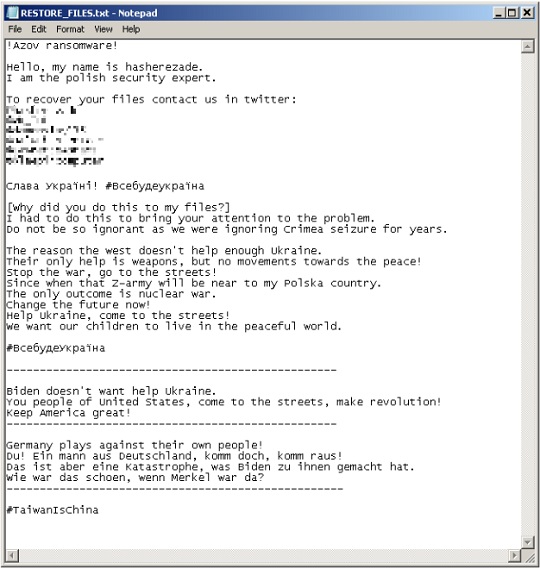Ransom.Win64.AZVO.A
Ransom:Win64/Azov.psyA!MTB (MICROSOFT)
Windows


Threat Type: Ransomware
Destructiveness: No
Encrypted: Yes
In the wild: Yes
OVERVIEW
This Ransomware arrives on a system as a file dropped by other malware or as a file downloaded unknowingly by users when visiting malicious sites.
It drops files as ransom note. It avoids encrypting files with the following file extensions.
TECHNICAL DETAILS
Arrival Details
This Ransomware arrives on a system as a file dropped by other malware or as a file downloaded unknowingly by users when visiting malicious sites.
Installation
This Ransomware drops the following files:
- %ProgramData%\rdpclient.exe ← copy of %System%\msiexec.exe or %System%\perfmon.exe infected with azvo ransomware code
(Note: %System% is the Windows system folder, where it usually is C:\Windows\System32 on all Windows operating system versions.)
It adds the following mutexes to ensure that only one of its copies runs at any one time:
- Local\azov
- Local\Kasimir_{Letter of Drive being Encrypted}
Autostart Technique
This Ransomware adds the following registry entries to enable its automatic execution at every system startup:
HKEY_LOCAL_MACHINE\SOFTWARE\Microsoft\
Windows\CurrentVersion\Run
Bandera = %ProgramData%\rdpclient.exe
Other Details
This Ransomware does the following:
- It checks if msiexec.exe or perfmon.exe is present in the machine's %System% folder:
- If msiexec.exe or perfmon.exe is present, it checks if rdpclient.exe is present in the machine's %ProgramData% folder:
- If rdpclient.exe is not present, it copies msiexec.exe or perfmon.exe as rdpclient.exe in %ProgramData% and injects malicious codes to it.
- If msiexec.exe or perfmon.exe is present, it checks if rdpclient.exe is present in the machine's %ProgramData% folder:
- It only encrypts if date and time is on or after:
- Oct 27, 2022 10:14:29 AM
- It uses intermittent encryption - encrypts 666 bytes then skips 666 bytes
- It injects its code to executable files that meets the following conditions:
- The file is not found in the list of avoided folders/paths
- The file extension is .exe
- The file size is less than 20MB
- The file is a 64-bit executable file
- The PE section containing the entry point has enough space for the shellcode to be injected
(Note: %ProgramData% is a version of the Program Files folder where any user on a multi-user computer can make changes to programs. This contains application data for all users. This is usually C:\ProgramData on Windows Vista, 7, 8, 8.1, 2008(64-bit), 2012(64-bit) and 10(64-bit), or C:\Documents and Settings\All Users on Windows Server 2003(32-bit), 2000(32-bit) and XP.)
Ransomware Routine
This Ransomware avoids encrypting files with the following strings in their file name:
- RESTORE_FILES.txt
It avoids encrypting files found in the following folders:
- Windows
- Program Data
- cache2\entries
- Low\Content.IE5
- User Data\Default\Cache
- Documents and Settings
- All Users
It appends the following extension to the file name of the encrypted files:
- .azov
It drops the following file(s) as ransom note:
- {Encrypted Path}\RESTORE_FILES.txt

It avoids encrypting files with the following file extensions:
- .dll
- .exe
- .ini
- .azov
SOLUTION
Step 1
Trend Micro Predictive Machine Learning detects and blocks malware at the first sign of its existence, before it executes on your system. When enabled, your Trend Micro product detects this malware under the following machine learning name:
- Troj.Win32.TRX.XXPE50FFF071
Step 2
Before doing any scans, Windows 7, Windows 8, Windows 8.1, and Windows 10 users must disable System Restore to allow full scanning of their computers.
Step 3
Note that not all files, folders, and registry keys and entries are installed on your computer during this malware's/spyware's/grayware's execution. This may be due to incomplete installation or other operating system conditions. If you do not find the same files/folders/registry information, please proceed to the next step.
Step 4
Restart in Safe Mode
Step 5
Delete this registry value
Important: Editing the Windows Registry incorrectly can lead to irreversible system malfunction. Please do this step only if you know how or you can ask assistance from your system administrator. Else, check this Microsoft article first before modifying your computer's registry.
- In HKEY_LOCAL_MACHINE\SOFTWARE\Microsoft\Windows\CurrentVersion\Run
- Bandera = %ProgramData%\rdpclient.exe
- Bandera = %ProgramData%\rdpclient.exe
Step 6
Search and delete this file
- %ProgramData%\rdpclient.exe
- {Encrypted Path}\RESTORE_FILES.txt
Step 7
Restart in normal mode and scan your computer with your Trend Micro product for files detected as Ransom.Win64.AZVO.A. If the detected files have already been cleaned, deleted, or quarantined by your Trend Micro product, no further step is required. You may opt to simply delete the quarantined files. Please check this Knowledge Base page for more information.
Step 8
Restore encrypted files from backup.
Did this description help? Tell us how we did.

